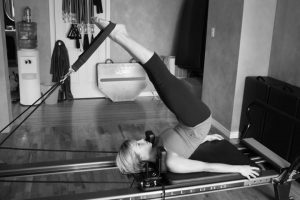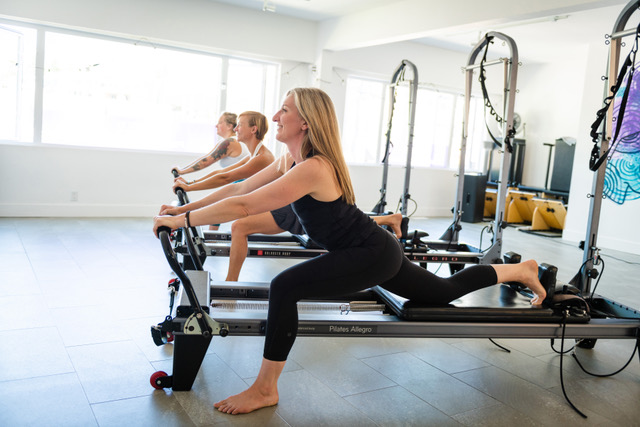There is probably no piece of Pilates Equipment more famous than the Pilates Reformer — and for good reasons. The reformer makes a dramatic impression when you first see one, and an even more dramatic change in your body when you use it.
What Is a Pilates Reformer?
The reformer was invented by Pilates founder Joseph Pilates. It is a bed-like frame with a flat platform on it, called the carriage, which rolls back and forth on wheels within the frame. The carriage is attached to one end of the reformer by a set of springs. The springs provide choices of differing levels of resistance as the carriage is pushed or pulled along the frame. The carriage has shoulder blocks on it that keep practitioners from sliding off the end of the reformer as they push or pull the carriage.
At the spring end of the reformer, there is an adjustable bar called a footbar. The footbar can be used by the feet or hands as a practitioner moves the carriage. The reformer also has long straps with handles on them that are attached to the top end of the frame.

Pilates Reformer
Benefits of Pilates Reformer Exercises
The reformer offers all the benefits of Pilates: including overall strength, flexibility, coordination, and balance. These things, in turn, lead to daily life improvements like better posture, graceful and efficient movement, and for many, relief from pain associated with physical imbalances such as back pain.
The Pilates Powerhouse muscles—the muscles of the core—are paramount for building strength.
Stronger Abs, strong backs, toned buttocks, and firm thighs are all results of this emphasis. Other equipment and Pilates Mat classes do that too, but the reformer creates a unique and varied exercise environment.
The reformer is large enough to accommodate full-range motion, which is wonderful for increasing flexibility while building strength. It seems to invite the length you want to create in the body, and it trains the body to sustain that length.
Pushing and pulling with legs or arms against the resistance of the springs, carriage, and body weight is generally strength building. The exercises provide enough resistance and movement variety to help build strong bones.
And there is a special feature – eccentric muscle contractions. This is when a muscle lengthens as it resists a force. The reformer’s set-up for eccentric contraction is one of the keys to achieving the long, strong muscles without bulk for which Pilates is known.
The instability of a rolling carriage with the springs set at different levels of resistance provides all kinds of stability challenges that develop core strength and promote better balance. For example, having less of the body on the carriage is one of the ways Pilates exercises get harder. It means more body weight has to be supported by the practitioner, and the body and machine have to be controlled even more from the core. Paradoxically, when the springs are in a lighter setting, some exercises are more challenging for the core because it has to work harder to control and stabilize the movement. The stronger the core, the better the balance, posture, and overall well-being.
Exercising with the reformer is possible for anyone, at any level of fitness. It’s no wonder the full name of the reformer is the universal reformer.


HI there,
Sarah from next door at Bodyside Laser Clinic. I am interested in the reformer classes…. I think you have a session starting in July with Lauren. I would be interested in the Tuesday morning class.
Kind regards
Sarah
Here you are!!! So glad we got connected on the email. Love and light